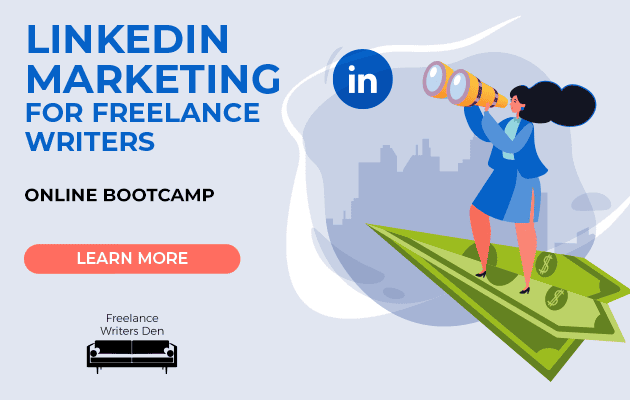Have you heard of LinkedIn Marketplaces?
You know…the magical kingdom where you hang up your digital “Open to Work” sign and great clients flood your inbox to hire you for freelance work.
That sounds pretty good, right?
One of the biggest challenges freelance writers struggle with is the hunt for clients.
You pitch an editor and never hear back.
You send out countless LOIs, hoping for a bite.
Or you get sucked into writing for low-paying content mills and bid-site platforms, thinking…”If I can just work around the clock, maybe I’ll earn enough to get by.”
Or maybe you do a big marketing push that doesn’t deliver, and you’re devastated.
Been there, done that?
What if you could tap into LinkedIn’s 740 million users better than you can right now to find freelance work? Would you go for it?
Before you fingers start flying across the keyboard to look up “LinkedIn Marketplaces,” there’s something you need to know.
It’s not available…not yet anyway.
But there’s a lot of buzz in the gig economy about LinkedIn Marketplaces set to launch later this year.
Here’s what you need to know…
What is marketplaces by LinkedIn?
Once upon a time, there was a LinkedIn service called ProFinder.
Clients looking for a writer post a project on LinkedIn and ProFinder subscribers get to bid on the project.
(Yep, subscription services and advertising is how LinkedIn makes money. Last year LinkedIn made an estimated $8.8 billion.)
Sounds pretty good, right?
But when we talked to freelance writers using ProFinder, the results were mixed:
- Laura MacPherson: “I’ve had good luck with it, but I also don’t pitch 90 percent of the gigs on there.”
- Margaret Ziviski said there’s a ton of resume-writer requests, and prospects who aren’t necessarily familiar with professional freelancing rates. “I suspect staying away from solopreneurs is a good idea.”
And then we got a different perspective…
- Troy Lambert: “In the last two years, I’ve made nearly six figures writing for clients I’ve landed through LinkedIn Profinder.”
But if the results were mixed and most writers didn’t profit using the service, maybe it could be revamped (enter LinkedIn Marketplaces) to produce better results and make LinkedIn more money.
When did marketplaces by LinkedIn start?
When COVID-19 began spreading across the globe, there were bigger problems than just rising infection rates.
- Some businesses were forced to close their doors…for good.
- Layoffs and unemployment went up.
- Traditional 9-to-5 offices scrambled to figure out how to manage tech tools to create a remote workforce overnight.
But it also gave the gig economy a boost.
Sites like Fiverr and UpWork generated about $550 million revenue combined last year.
Here’s how these models typically work:
- You create an account on the platform
- Optimize your profile, offering a service (like freelance writing, content marketing, editing, etc.)
- Set your rates or quote price for a project.
- When someone books a project with you, they fund it through the platform.
- And when the work is done, you get paid and the platform takes a cut (Upwork and Fiverr both get up to 20% per transaction)
In other words, there’s a lot of money going around in the gig economy, and LinkedIn wants a piece.
LinkedIn plans to retire ProFinder and replace it with a gig-economy model similar to these.
“LinkedIn is developing a new service called Marketplaces to let its 740 million users find and book freelancers, pitting it against publicly traded firms such as Upwork and Fiverr,” according to The Information.”
How do you use LinkedIn marketplaces?
So when can you sign up for LinkedIn Marketplaces and start booking more work?
As of Oct 27, 2021, LinkedIn Marketplace is officially live and ready to use, according to this post from Matt Faustman, the head of product at LinkedIn.

There are currently 250 job categories to choose from, with more coming soon.
Why freelancers should use LinkedIn Marketplaces?
One of the features that attracts freelance writers to platforms like Fiverr and UpWork is the model for getting paid.
Projects are funded by clients first. When you complete a project, you get paid, without the old-school hassles of invoicing, nagging accounts payable, or even sending a client to collections.
At Fiverr, UpWork and other platforms, you can even decide where you want your funds to go:
- Keep the funds in your account on the platform
- Transfer the funds to your PayPal account
- Or move the funds to a checking or savings account
What will the LinkedIn Marketplaces payment model look like?

“Microsoft-the parent company of LinkedIn-is…focusing their efforts on creating a digital wallet that will be compatible throughout several of its platforms, including Marketplaces,” says Forbes contributor,” Gene Marks.
The model is expected to look similar to Fiverr and UpWork, and allow users to store money that can be used for LinkedIn services and subscriptions, along with Microsoft-friendly sites, or transferred to a bank account.
Is LinkedIn marketplaces free?
LinkedIn Marketplace is free for service providers and freelancers to use.
Where to post LinkedIn marketplaces?
Once you’re looking at your profile, you should see an “Open to” button.

Once you click on that and select “providing services” it will guide you through a few steps to get up and running.
You can currently offer 10 services, which should be more than enough for most freelancers.
Leverage LinkedIn to land more freelance writing work
LinkedIn Marketplaces isn’t open for business yet. But you should already be using the platform.
It’s the best place online to connect with marketing directors, editors, and agencies that hire freelance writers. And it’s easy…
- Reach out.
- Make connections.
- Start conversations.
- Post, comment, like, and share useful information your ideal clients care about
When LinkedIn Marketplaces launches later this year, it’s worth a closer look to help you move up and earn more.
Will you use LinkedIn Marketplaces for freelance work? Let’s discuss in the comments below.
Evan Jensen is a freelance copywriter for health and fitness businesses. He’s also the blog editor for Make a Living Writing.
